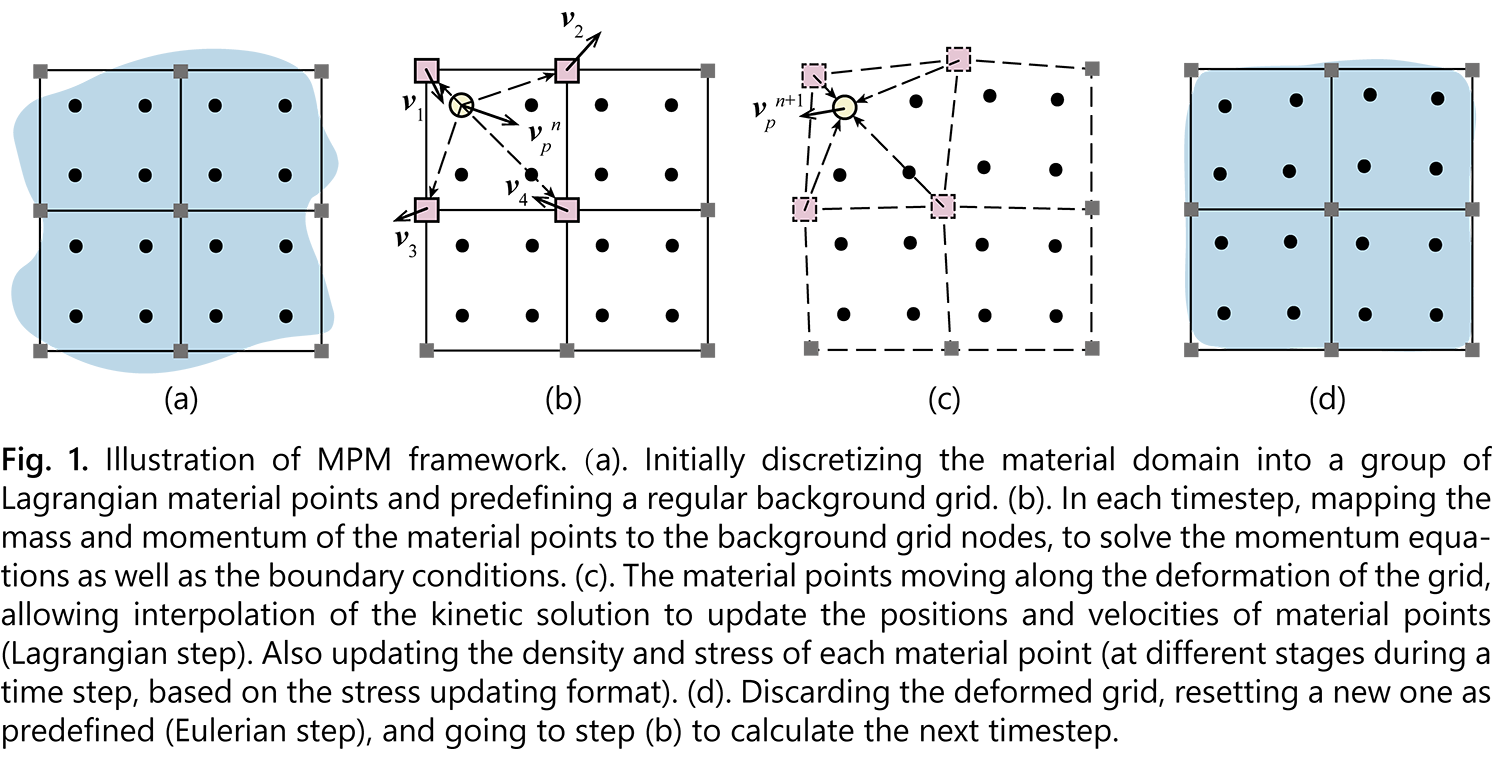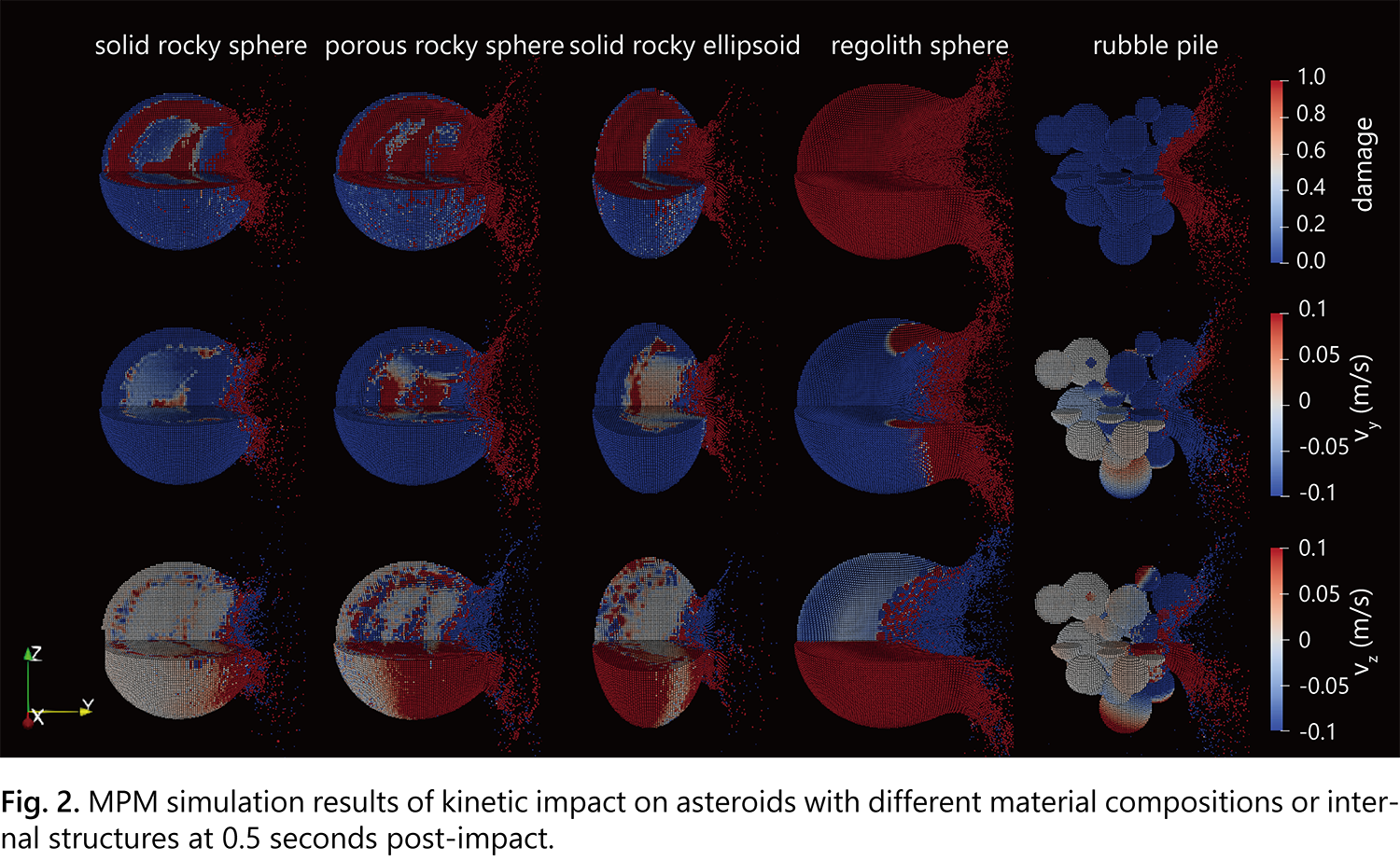Assessing the influence of asteroid composition and structure on kinetic impact deflection efficiency: an MPM approach
- 1School of Aerospace Engineering, Tsinghua University, Beijing, China (yanxr159@gmail.com)
- 2Observatory Cote d'Azur, University Cote d'Azur, CNRS, Nice, France
- 3Department of Systems Innovation, School of Engineering, University of Tokyo, Tokyo, Japan
Introduction The successful DART mission has validated kinetic impact as the most effective method for deflecting or disrupting potentially hazardous asteroids [1]. The impact produced unexpectedly intense material ejection, expanding our understanding of asteroid response to hypervelocity collisions [2]. What insights might this violent fragmentation and ejecta reveal about Dimorphos's material strength and structural composition? Exploring these aspects before the upcoming Hera mission [3] can optimize mission design and interpretation.
The artificial impact experiment conducted by the Hayabusa2 mission demonstrated the influence of geological structures on cratering events [4, 5]. Similarly, understanding how the material and structural composition of an asteroid affect kinetic impact efficiency is crucial for planetary defense. To capture the detailed structure of asteroids, here we employ the Material Point Method (MPM), which excels in handling contact and interface problems, for modeling and simulation, aiming to address these critical questions.
Method The material point method (MPM) is a well-developed numerical technique in the mechanical industry, but remains underestimated potential in the field of planetary science. MPM discretizes the continuum body into Lagrangian material points and employs a rigidly attached Eulerian background grid at each time step, with the algorithmic flow illustrated in Fig. 1. By combining the strengths of both Lagrangian and Eulerian descriptions, MPM effectively eliminates numerical dissipation and expedites the search for neighbor points, resulting in an efficient, extendable, and robust shock-physics code. This feature makes MPM particularly well-suited for simulating complex geometries and contact interactions, which are common in planetary science applications.

To accurately capture the dynamical behavior of materials under hypervelocity impact, a modified pressure-dependent and damage-dependent Lundborg smooth yield model is adopted for the strength model, coupled with a quantitative plasticity correction. The Tillotson equation of state (EOS) is utilized in conjunction with a sound speed modification. Besides, a resolution-independent Grady-Kipp damage model is employed to simulate the fracture process. In the future, we plan to further develop the p-alpha equation to characterize the pore compaction effect.
These proposed algorithms and material models have undergone extensive benchmarking and validation, spanning a wide range of parameter spaces, demonstrating their capability to describe the potential dynamic behavior of small celestial body materials [6]. This comprehensive approach, combining state-of-the-art numerical methods and material models, paves the way for a deeper understanding of the dynamic properties of small celestial bodies and their constituent materials.
Simulation and Result Constrained by computational resources, we designed simulation scenarios based on China's upcoming kinetic impact mission [7]. A cubic spacecraft (1.5 m in size, 600 kg in mass) impacts a spherical target body (35 m in diameter) at a velocity of 10 km/s. Given the unknown material and structure of the target, we investigated the dynamic responses of small bodies with various structures (monolithic or rubble pile), geometries (spherical or ellipsoidal), and material compositions (rocky or regolith, solid or porous). Except for the solid rocky material with a density of 2700 kg/m3, all other target bodies have equal mass and a bulk density of 1200 kg/m3. Classic basaltic material parameters were used for all materials, except for the regolith, which has lower strength. The ejecta, damage, and velocity distributions after 0.5 s of impact are visually presented in Fig. 2. We further analyzed the momentum enhancement factor and the mass and velocity distributions of the fragments for each case.

Discussion and Conclusion The dynamic responses to hypervelocity impacts exhibit significant sensitivity to the target's material and structure, as evidenced by the ejecta intensity, ejection angles, fragment morphology, velocity, and angular velocity. Investigating the relationship between target structure and impact response is crucial for mission design and ejecta avoidance. Moreover, it helps unravel the physical properties of the target body from observational results. This study focused on perpendicular impacts and analyzed the results during the impact fragmentation phase. Future research may delve into the orbital dynamics of the fragments, evaluate the effectiveness of impact defense in mitigating Earth-threatening hazards, and explore the potential of oblique impacts to disrupt the target body through spin-up. These findings may also extend to impacts between asteroids and shed light on phenomena such as binary formation, which contributes to our understanding of the origin and evolution of small celestial bodies in the solar system.
Acknowledgment X.Y. and J.L. acknowledge support from the National Natural Science Foundation of China under Grant 12372047. X.Y. acknowledges support from the National Natural Science Foundation of China under Grant 62227901. P.M. acknowledges support from the French space agency CNES and from the French National Centre for Scientific Research (CNRS) through the exploratory research program of the Mission for Transversal and Interdisciplinary Initiatives.
References [1] Daly, R. T. et al. (2023) Nature 616(7957), 443–447. [2] Cheng, A. F. et al. (2023) Nature 616(7957), 457–460. [3] Michel, P. et al. (2022) Planet. Sci. J. 3(7), 160. [4] Arakawa, M. et al. (2020) Science 368(6486), 1–10. [5] Jutzi, M. et al. (2022) Nat. Commun. 13(1), 7134. [6] Yan, X. et al. (2023) ACM Conference. [7] Zou, Y. et al. (2024) J. Deep Space Explor. 11(2), 1-8.
How to cite: Yan, X., Zhou, W., Michel, P., and Li, J.: Assessing the influence of asteroid composition and structure on kinetic impact deflection efficiency: an MPM approach, Europlanet Science Congress 2024, Berlin, Germany, 8–13 Sep 2024, EPSC2024-260, https://doi.org/10.5194/epsc2024-260, 2024.